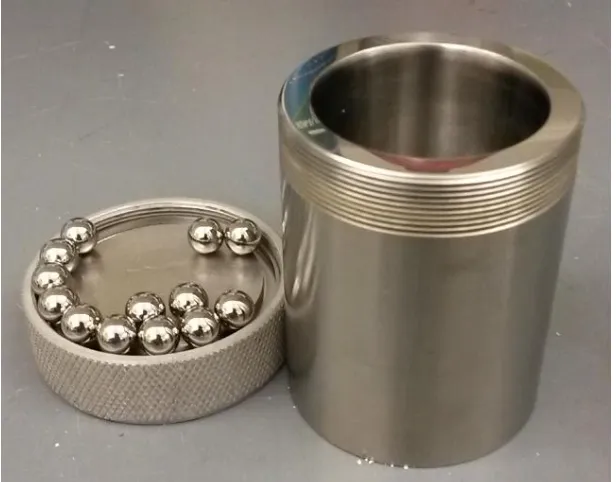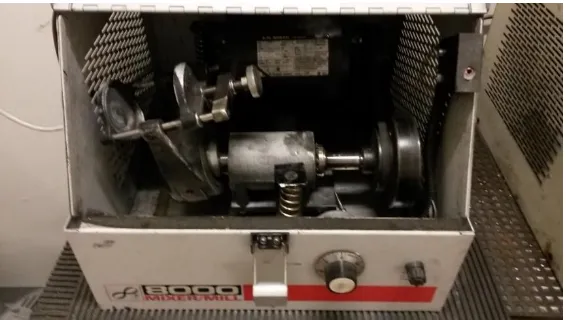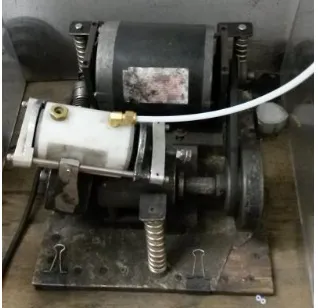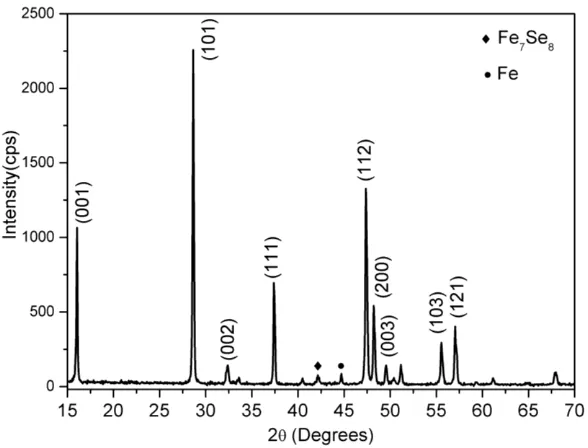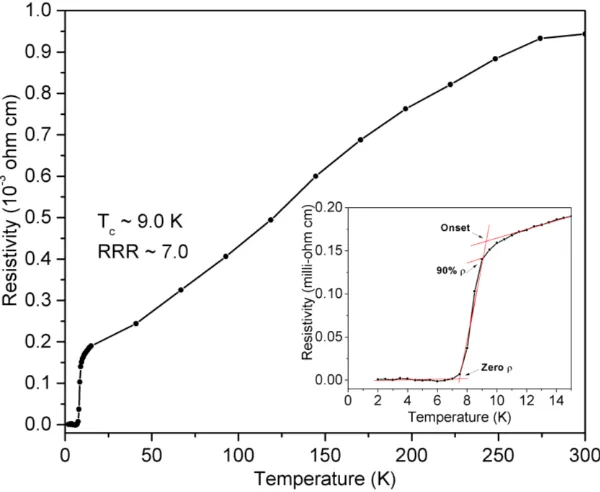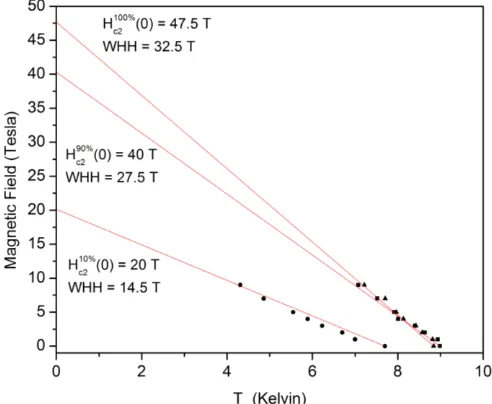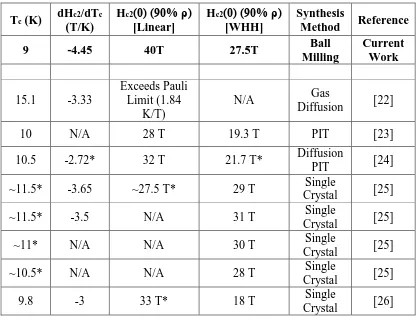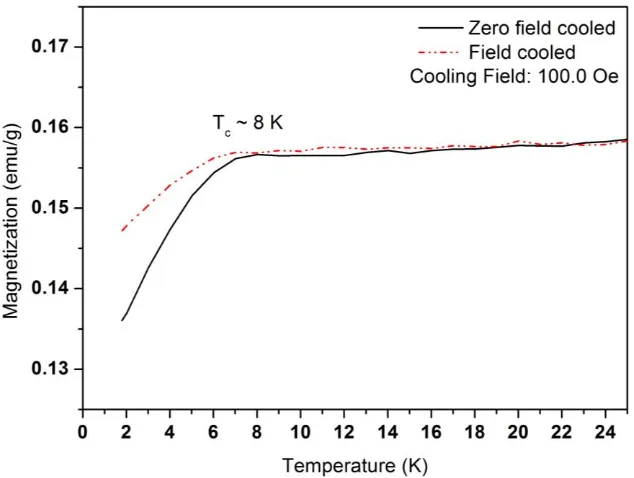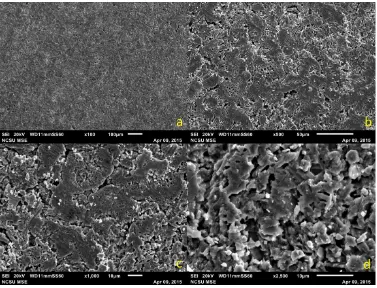ABSTRACT
LEDFORD, JOHN CHRISTOPHER. Synthesis and Properties of Binary and Ternary Iron Based Superconductors via Mechanical Alloying. (Under the direction of Dr. Frank Hunte).
With the emergence of the iron-based superconductors, research efforts have been focused on the processing routes necessary for the synthesis of pure samples (free of extra phases) which exhibit strong superconducting properties. In this work, iron selenide (Fe1.015Se) was prepared using planetary ball milling for 48 hours and pressed into pellets with subsequent heat treatment at 400 °C for 24 hours. The pellets were annealed inside a tungsten carbide die to minimize loss of selenium during heat treatment. The composition and confinement during annealing allowed for the synthesis of high purity samples with approximately 94% of the superconducting β-FeSe phase as determined by Rietveld analysis of the XRD data. The temperature of the onset of the superconducting transition (Tc) was 9.0 K at 90% ρ as determined by transport measurements with a zero resistivity temperature of 7.8 K. This transition width is narrow compared to other reported samples of similar processing and is attributed to the high percentage of β-FeSe present in the sample. Magnetization measurements yielded a transition temperature of 8.0 K which is in agreement with the Tc obtained from transport measurements. The upper critical field (Hc2(0)) of this sample was 27.5 T determined at 90% ρ and using a Werthamer–Helfand–Hohenberg (WHH) fit to the data. This high Hc2(0) for the polycrystalline samples is comparable to that reported for single crystal samples.
for 4 hours. All powders were pressed into pellets with subsequent heat treatment at 700 °C for 1 hour and 700 °C for 40 hours. The superconducting temperature for the high energy SPEX milling and cryomilling was shown to be the highest of the three milling processes with a temperature around ~14.3K. The upper critical field (Hc2(0)) was found to be highest in the high energy ball milling processes most likely due to a higher concentration of defects introduced during the milling process. Magnetization measurements are in agreement with the
Synthesis and Properties of Binary and Ternary Iron Based Superconductors via Mechanical Alloying
by
John Christopher Ledford
A thesis submitted to the Graduate Faculty of North Carolina State University
in partial fulfillment of the requirements for the degree of
Master of Science
Materials Science and Engineering
Raleigh, North Carolina 2015
APPROVED BY:
_______________________________ _______________________________
Dr. Frank Hunte Dr. C. Lewis Reynolds Jr.
Committee Chair
_______________________________ _______________________________
ii DEDICATION
iii BIOGRAPHY
iv ACKNOWLEDGMENTS
I would like to thank my committee members; Dr. Hunte, Dr. Reynolds, Dr. Scattergood, and Dr. Koch for all of their help with my research and assistance through graduate school. I would like to thank Dr. Zhu for the use of his glovebox which allowed me to continue with my project. I would like to thank my fellow group members, Christer and Raj, for all their help in getting me to this point in my career. There was never a moment when they would not lend a helping hand and I am grateful for that. I would like to thank Edna for all of her help through the process and making sure that everything was taken care of.
A special thanks to Roger and Toby for all the help over the years in not only school and research but so much more in my personal life. I have a countless number of friends which I have to thank for all their help with school, research, and life in general and would like to extend my gratitude to everyone who has helped me along the way.
v TABLE OF CONTENTS
LIST OF TABLES……….….…..…….vi
LIST OF FIGURES………..…..………..…vii
Chapter 1: Introduction………..………..……..1
Chapter 2: Synthesis of FeSe and FeSeTe……..………...8
Chapter 3: Characterization of FeSe and FeSeTe ………..………11
3.1 X-ray Diffraction…..………..………….……….11
3.2 Scanning Electron Microscopy……….….………..11
3.3 Transport………..…..……..11
3.4 Magnetization………..………..……...12
3.5 Critical Current……….………..…….12
Chapter 4: High Upper Critical Field of β-FeSe Processed by Mechanical Alloying..…13
4.1 Scanning Electron Microscopy…….………..………..………...13
4.2 X-ray Diffraction…….………..………...15
4.3 Transport………..………16
4.4 Magnetization………...….………...19
Chapter 5: Enhancement of the Superconducting Properties of the Ternary FeSeTe via High Energy Ball Milling………..………21
5.1 Introduction.……….….………..21
5.2 Scanning Electron Microscopy.……….………...………..21
vi
5.4 Magnetization………..….……….…………...32
5.5 Critical Current………...……….39
5.6 Summary………..………….40
Chapter 6: Summary and Future Work………...………42
6.1 Summary……….………..42
6.2 Conclusions……….………..43
6.3 Future Work………...………….………...43
vii LIST OF TABLES
Table. 4.1. Comparison of the upper critical field characteristics, Hc2||c calculated from linear extrapolation and the WHH method, of FeSe samples reported here to those presented in the literature along with their reported Tc values and synthesis method. Values with an asterisk (*) were calculated from given plots in the literature.
Properties for this study are listed first………..18 Table. 5.1. Summary of the superconducting properties of the planetary ball milling,
viii LIST OF FIGURES
Figure. 1.1. Temperature dependence of resistance of a normal metal and a
superconductor………1 Figure 1.1. Stainless steel vial and milling media used for Fe50Se25Te25 synthesis……….8 Figure 2.2. Planetary ball mill setup for Fe50Se25Te25 synthesis………..9 Figure 2.3. High energy SPEX ball mill setup for Fe50Se25Te25 synthesis………...9 Figure 2.2. Cryomilling setup for Fe50Se25Te25 synthesis………...10 Figure. 4.1. Representative SEM image of the internal microstructure of the Fe1.015Se
pellets………..…14 Figure. 4.2. XRD spectrum for Fe1.015Se pellets. Impurities are marked above the
peaks……….………..14 Figure. 4.3. Temperature dependence of resistivity for Fe1.015Se pellets. The inset shows
an expanded view of the superconducting transition. The overlaid (red) lines show how the transition temperatures at onset, 90% ρ, and zero ρ were determined…….15 Figure. 4.4. Temperature dependence of resistivity for the Fe1.015Se pellets under
different applied magnetic fields up to 9 T………..………...17 Figure. 4.5. Upper critical field linear extrapolation for the Fe1.015Se pellets at 100%,
90%, and 10% ρ. Hc2||c determined by linear extrapolation and the WHH method are shown……….………..17 Figure. 4.6. Zero field and field cooled magnetization versus temperature
ix Figure. 5.1. Scanning electron micrographs at 100X (a), 500X (b), 1000X (c), and 2500X
(d) of the planetary balled milled Fe50Se25Te25 sample………..22 Figure. 5.2. Scanning electron micrographs at 100X (a), 500X (b), 1000X (c), and 2500X
(d) of the high energy SPEX milled Fe50Se25Te25 sample………....……..23 Figure. 5.3. Scanning electron micrographs at 100X (a), 500X (b), 1000X (c), and 2500X (d) of the cryomilled Fe50Se25Te25 sample……….…...24 Figure. 5.4. Temperature dependence of resistivity from 3K to 300K for planetary ball
milled Fe50Se25Te25. The inset shows an expanded view from 3K to 20K with the overlaid black lines showing how the transition temperature at onset was taken…..25 Figure. 5.5. Temperature dependence of resistivity from 4K to 300K for high energy
SPEX milled Fe50Se25Te25. The inset shows an expanded view from 4K to 20K.…...27 Figure. 5.6. Temperature dependence of resistivity from 3K to 300K for cryomilled
Fe50Se25Te25. The inset shows an expanded view from 3K to 20K………….………..28 Figure. 5.7. Temperature dependence of resistivity for planetary ball milled
Fe50Se25Te25 under different applied magnet fields up to 9 T………..…….……29 Figure. 5.8. Temperature dependence of resistivity for high energy SPEX milled
Fe50Se25Te25 under different applied magnet fields up to 9 T………...…………30 Figure. 5.9. Temperature dependence of resistivity for cryomilled Fe50Se25Te25 under
x Figure. 5.11. Field cooled (red) and zero field cooled (black) temperature dependence of
magnetization from 3K to 300 K of planetary ball milled Fe50Se25Te25………..…….34 Figure. 5.12. Field cooled (red) and zero field cooled (black) temperature dependence of magnetization from 3K to 25 K of high energy SPEX milled Fe50Se25Te25……….…35 Figure. 5.13. Field cooled (red) and zero field cooled (black) temperature dependence of magnetization from 3K to 300 K of high energy SPEX milled Fe50Se25Te25………...36 Figure. 5.14. Field cooled (red) and zero field cooled (black) temperature dependence of magnetization from 3K to 20 K of cryomilled Fe50Se25Te25……….……….37 Figure. 5.15. Field cooled (red) and zero field cooled (black) temperature dependence of magnetization from 3K to 300 K of cryomilled Fe50Se25Te25………38 Figure. 5.16. Critical current measurements for planetary, SPEX, and cryomilled
1 Chapter 1
Introduction
Superconductivity has been the subject of extensive research since its discovery in 1911 by Dutch physicist Heike Kamerlingh Onnes. Onnes was the first scientist to liquefy helium which allowed him to make the first observations of superconductivity as the electrical resistance of pure mercury dropped to zero below its critical temperature Tc ~ 4.2K [1, 2]. Following this observation, low temperature resistivity measurements were performed on a number of pure elements and alloys to determine what other materials might show this newly discovered phenomenon which Onnes called superconductivity.
A significant characteristic of superconductivity is the observation of zero resistivity below some critical temperature as compared to normal metals which retain some residual resistivity down to the lowest temperature. The resistivity of a superconducting material in the normal state is comparable to or higher that of a typical metal.
2 The existence of the superconducting state is dependent on the temperature at which the superconductor is maintained, the magnetic field which is present and current which it conducts. Superconductors are classified into two categories, type I & II, which describes their behavior when an external magnetic field is applied. Type I superconductors show a sharp transition from the superconducting state to the normal state when a sufficiently high magnetic field is applied. Type I superconductors are typically pure metals. Type II superconductors exhibit a different behavior and are characterized by two critical fields, the upper and lower critical fields. Below the lower critical field, Hc1, the externally applied magnetic field is completely expelled from the interior of the superconductor. Above the upper critical field, Hc2, the externally applied magnetic field penetrates the superconductor causing it to revert to the normal state. A mixed state exists between the lower critical and upper critical fields where the material maintains superconducting properties with the existence of a flux vortex lattice. Applied currents in the superconductor can also cause superconductivity to diminish and/or disappear. This critical current density, JC, is the maximum amount of lossless current that the superconductor can support before superconductivity breaks down and a voltage is observed. This occurs because the overall magnetic field in the superconductor exceeds the critical field value due to the transport current and externally applied magnetic field [3].
3 Dy, Ho, Er, Tm, Yb),also called the 123 oxides, showed superconductivity in the 90K range which is higher than the boiling point of nitrogen [5]. With transition temperatures climbing higher and higher, the race to discover a room temperature superconductor has fueled recent research in the field.
4 could be substituted by safer materials. It has been shown that iron chalcogenides can show superconducting behavior while not containing these toxic additions such as the pnictides.
FeSe is structurally the most simple of the iron-based superconducting materials with a tetragonal superconducting phase in which superconductivity has been observed so far with a Tc ~8 K [7, 10]. Medvedev et al used pressures up to 9GPa to increase the transition temperature to 36.7K [11]. McQueen et al found that the stoichiometry for the β-FeSe superconducting phase is extremely sensitive to changes in the selenium content. A slightly non-stoichiometric composition in favor of iron is needed in order to produce a pure superconducting sample. When the stoichiometry of the samples is iron-rich then the β-FeSe is formed along with excess iron. When the stoichiometry is not iron-rich, then the β-FeSe is formed along with the δ-FeSe phase which is not superconducting. A temperature range also exists between 300 and 450K for which a pure β-FeSe phase is possible and below this range the hexagonal FeSe phase is dominant [12]. It has been shown that tellurium substitution of the binary FeSe compound can increase the transition to ~15K and is not nearly as stoichiometrically sensitive as FeSe. The optimal substitution level of tellurium seems to be around 50% but can vary and still show a superconducting phase [13-15].
5 to form the new compounds [16]. This can lead to a long sample preparation time in order to get a truly uniform sample and in most cases the samples will be small in size. The Bridgman method melts the chemical elements of the compound to be produced and then slowly cooled to allow crystallization of the superconducting phase. This process is done in an inert crucible which has been sealed to prevent loss of any precursors. Care must be taken in the synthesis of some compounds due the high melting temperatures of the precursors and synthesis vessel thermal stability. The flux method uses a supersaturated solution which is slowly cooled to allow crystallization of the superconducting phase similar to that of the Bridgman method. This method allows for shorter crystal growth times and lower temperature synthesis [16]. Both the Bridgman and flux methods produce small single crystal samples. Another processing technique that can be implemented in the synthesis of these iron based superconductors is mechanical alloying also known as ball milling.
6 superconducting phase due to the formation of FeSe2 which resulted in a reduction of evaporation of selenium giving a more favorable stoichiometry. It was also shown that with an extended milling time (>50 hours) that the superconducting phase was suppressed as seen by Xia [18]. Li however shows that a higher sintering temperature of 750°C produces a higher percentage of the β-FeSe phase which produced a transition temperature of ~10.1K measured by resistance [19]. Li also reported planetary ball milling of the ternary Fe-Se-Te which has a higher transition temperature. It was found that also with shorter milling times the amount of β-FeSe superconducting phase increased which helps to enhance the overall superconducting properties. The 20 hour ball milled sample showed a transition temperature of ~14K while the 80 hour milled sample showed no superconducting properties [20].
8 Chapter 2
Synthesis of FeSe and FeSeTe
Fe1.015Se and Fe50Se25Te25 samples were prepared using pure Fe, Se, and Te powders (Alfa Aesar/99.9%/200 mesh, Alfa Aesar/99.999%/<10 micron, and Alfa Aesar/99.99%/200 mesh respectively). The powders were loaded into a stainless steel vial under an argon atmosphere and sealed with an O-ring as seen in Figure 2.1.
Figure 4.1: Stainless steel vial and milling media used for Fe50Se25Te25 synthesis
9 powders were planetary ball milled at 275 rpm using a GlenMills Planetary Ball Mill for 48 hours as seen in Figure 2.2.
Figure 2.2: Planetary ball mill setup for Fe50Se25Te25 synthesis
This milling process was chosen because it is a lower energy process and contamination from the milling vial and media could be minimized. Powders were milled using a SPEX 8000 high energy ball mill for 24 hours at room temperature as seen in Figure 2.3.
10 Powders were cryomilled utilizing a liquid nitrogen cooled SPEX 8000 high energy ball mill for 4 hours. The vial was cooled down initially by submerging in liquid nitrogen and then transferring to the mill where liquid nitrogen flowed through a nylon jacket during the milling process as seen in Figure 2.4.
Figure 2.5: Cryomilling setup for Fe50Se25Te25 synthesis
11 Chapter 3
Characterization of FeSe and FeSeTe
3.1 X-ray Diffraction
The phases present in the Fe1.015Se and Fe50Se25Te25 pellets were characterized by X-ray diffraction (XRD) using a Rigaku Smart Lab Diffractometer with Cu K-α radiation (λ=0.154 nm). Peak identification and superconducting phase percentage were calculated using PANalytical Highscore Plus diffraction software and the International Centre for Diffraction Data (ICDD) database. The software utilizes the Rietveld Method to calculate phase percentages from the XRD results [21].
3.2 Scanning Electron Microscopy
Scanning electron microscopy was chosen to examine the microstructure of the samples. It was important to determine the amount of porosity in the samples, which could depend on the milling and annealing conditions. A JEOL JSM-6010PLUS/LA scanning electron microscope (SEM) was used to characterize the internal structure of the pellets. Energy-dispersive X-ray spectroscopy (EDS) was used to determine the amount of Fe, Se, and Te present in the samples after annealing.
3.3 Transport
12 were performed using the linear four point probe method with a 9 Tesla Quantum Design Physical Property Measurement System (PPMS). This measurement can be used to determine the superconducting transition temperature by looking at the intersection where the material goes from a regular resistivity behaviour to the superconducting behaviour. All temperature dependent measurements were performed while heating through the transition temperature. Contacts to the samples were made with gold coated pogo pins.
3.4 Magnetization
Magnetization measurements were performed to determine the superconducting properties of the sample. Field cooled (FC) and zero field cooled (ZFC) magnetization measurements versus temperature were performed using a Quantum Design MPMS SQUID VSM with a cooling field of 100 Oersted. By looking at the transition of the magnetization where the moment starts to decrease versus temperature we can then determine where the material begins to exhibit superconducting behaviour.
3.5 Critical Current
13 Chapter 4
High Upper Critical Field of β-FeSe Processed by Mechanical Alloying
The β-FeSe phase is highly sensitive to stoichiometry; therefore, multiple iterations of sample composition and milling conditions were tested. A small stoichiometric window for superconductivity is known to exist in the β-FeSe phase which suggests a Se deficient composition [12]. Fe1.015Se was chosen due to it being on the lower end of the stoichiometric window which would still allow for the β-FeSe phase to occur while allowing for the presence of iron impurities. High energy SPEX ball milling was initially tested as the mechanical alloying process but no superconducting samples could be produced due to the presence of high iron impurities. A planetary ball milling process was adopted due to less abrasion of the milling vial wall and media which resulted in a lower amount of iron impurities. The purpose of annealing the pellets inside the tungsten carbide die was to prevent excessive expansion in the pellets due to the relatively low boiling point of selenium (685 °C). Samples annealed without the die lost selenium which altered the composition such that it was outside of the superconducting region.
4.1 Scanning Electron Microscopy
14 Figure 4.1: Representative SEM image of the internal microstructure of the Fe1.015Se pellets
15 4.2 X-ray Diffraction
XRD results for the Fe1.015Se pellets are shown in Figure 4.2. The pellets consist mostly of the superconducting tetragonal phase, β-FeSe, with a small amount of impurity phases including Fe7Se8 and pure Fe. The β-FeSe tetragonal phase volume percentage of the pellets was calculated to be ~94 % using the Rietveld Method [21]. The superconducting phase percentage is much higher than those reported in the literature for other ball milled samples [18, 19]. Fe impurities accounted for ~1.5% of the total sample. Also present in the sample was the non-superconducting hexagonal FeSe phase which accounted for ~4.5% of the sample.
16 4.3 Transport
Figure 4.3 shows the temperature dependence of resistivity for the Fe1.015Se pellets. The transition temperature (Tconset) was determined by the intersection of the two extrapolated lines, one from the linear region before the transition and the other from the straightest portion of the transition, as shown in the inset of Figure 4.3. Tconset for the Fe1.015Se pellets was determined to be 9.0 K, which is similar to those of other ball milled samples [17-19]. Zero resistivity is achieved at 7.8 K which results in a superconducting transition width ΔT of 1.2 K. This ΔT is considerably smaller than those reported in the literature for other ball-milled samples and is believed to arise from the high superconducting phase percentage of the sample [17-19].
The residual resistivity ratio (RRR) was calculated by taking the ratio of the normal state resistivity at 300 K and the resistivity just before the transition temperature in zero field. The Fe1.015Se pellets exhibited a RRR value of 7.0 which suggests toward a high purity sample.
17 Figure 4.4: Temperature dependence of resistivity for the Fe1.015Se pellets under
different applied magnetic fields up to 9 T.
Figure 4.5: Upper critical field linear extrapolation for the Fe1.015Se pellets at 100%, 90%, and 10% ρ. Hc2||c determined by linear extrapolation and the WHH method are shown.
18 values for Hc2||c (90%), these calculated values for Hc2||c (90%) are comparable to those reported for single crystal samples (Table 4.1).
Table 4.1: Comparison of the upper critical field characteristics, Hc2||c calculated from linear extrapolation and the WHH method, of FeSe samples reported here to those presented in the literature along with their reported Tc values and synthesis method. Values with an asterisk (*) were calculated from given plots in the literature.
Properties for this study are listed first. Tc (K) dHc2/dTc
(T/K)
Hc2(0) (90% ρ) [Linear]
Hc2(0) (90% ρ) [WHH]
Synthesis
Method Reference
9 -4.45 40T 27.5T Ball
Milling
Current Work
15.1 -3.33
Exceeds Pauli Limit (1.84
K/T)
N/A Gas
Diffusion [22]
10 N/A 28 T 19.3 T PIT [23]
10.5 -2.72* 32 T 21.7 T* Diffusion
PIT [24]
~11.5* -3.65 ~27.5 T* 29 T Single
Crystal [25]
~11.5* -3.5 N/A 31 T Single
Crystal [25]
~11* N/A N/A 30 T Single
Crystal [25]
~10.5* N/A N/A 28 T Single
Crystal [25]
9.8 -3 33 T* 18 T Single
Crystal [26]
The Hc2 characteristics of the samples were analyzed using the Werthamer–Helfand–
Hohenberg (WHH) model which gives 2
2
( )
(0) 0.693* * c ; (T T )
c c c
dH T
H T
dT
[27]. Hc2||c
19 respectively. The onset and 90% Hc2 values for the ball milled sample are on the same order as that for single crystals with similar superconducting phase percentage.
Figure 4.6: Zero field and field cooled magnetization versus temperature measurements for Fe1.015Se pellets.
4.4 Magnetization
21 Chapter 5
Enhancement of the Superconducting Properties of the Ternary FeSeTe via High Energy Ball Milling
5.1 Introduction
More complex iron based superconducting alloys have shown to exhibit higher critical temperatures and upper critical fields. After success with producing the
superconducting binary FeSe alloy, the ternary FeSeTe was seen a suitable candidate for the mechanical alloying synthesis. With a lower sensitivity to the stoichiometry, the
superconducting phase is much easier to obtain utilizing a mechanical alloying process. Planetary ball milling, high energy SPEX milling, and cryomilling processing techniques were utilized to synthesis the ternary FeSeTe. The superconducting properties of the samples were characterized by magnetization and resistivity as a function of temperature and applied magnetic field.
5.2 Scanning Electron Microscopy
22 Figure 5.1: Scanning electron micrographs at 100X (a), 500X (b), 1000X (c), and 2500X (d) of the planetary balled milled Fe50Se25Te25 sample
23 Figure 5.2: Scanning electron micrographs at 100X (a), 500X (b), 1000X (c), and 2500X (d) of the high energy SPEX milled Fe50Se25Te25 sample
24 Figure 5.3: Scanning electron micrographs at 100X (a), 500X (b), 1000X (c), and 2500X (d) of the cryomilled Fe50Se25Te25 sample
25 5.3 Transport
Figure 5.4 shows the temperature dependence of resistivity for the planetary ball milled sample. The inset shows an expanded view of the superconducting transition where two intersecting black lines are used to estimate the superconducting onset temperature (Tconset). One line is drawn through the linear part of the curve before the transition and the other is drawn through the linear portion of the transition to zero resistivity. Tconset at zero field for the planetary ball milled sample was estimated to be ~13.7K. Zero resistivity is estimated to be around ~12.4K which results in a sharp transition with a ΔT of ~1.3K.
27 Figure 5.5: Temperature dependence of resistivity from 4K to 300K for high energy SPEX milled Fe50Se25Te25. The inset shows an expanded view from 4K to 20K.
28 planetary ball milled sample and over 2 times larger than the high energy SPEX milled sample. This larger resistivity for the high energy ball milled samples is due to a larger scattering effect due to a higher concentration of defects introduced during the milling process.
29 Figure 5.7: Temperature dependence of resistivity for planetary ball milled Fe50Se25Te25 under different applied magnet fields up to 9 T
Magnetotransport measurements were run for each of the three milling conditions. Figure 5.7 shows the temperature dependence of resistivity from 0 to 9 Tesla. At 9 T, the sample has a Tconset of ~12.7K and is still able to reach zero resistivity at ~10.7K. By plotting the Tconset at each of the applied fields versus the applied magnet field, the upper critical field, Hc2||c(0), can be linearly extrapolated to zero kelvin which can give insight into the maximum field for which the sample can maintain superconductivity. For the planetary ball milled sample, the Hc2||c(0) was approximated to be ~134 Tesla with the linear approximation having a strong correlation to the data. Utilizing the Werthamer–Helfand–Hohenberg (WHH) model which says that
2 2
( )
(0) 0.693* * c ; (T T )
c c c
dH T
H T
dT
[27], we are able to calculate an alternative upper
30 transition temperature. Assuming that the Tconset is ~13.7K and the slope of the linear approximation is -9.82 K/T, the WHH method yields an Hc2||c(0) ~ 93.5 T. This Hc2||c(0) value is lower than that of the linear approximation but tends to be more accurate.
Figure 5.8: Temperature dependence of resistivity for high energy SPEX milled Fe50Se25Te25 under different applied magnet fields up to 9 T
31 which is almost a 7K difference. For the SPEX milled sample, the Hc2||c(0) was estimated to be ~159.7 T using the linear extrapolation model. Using a slope of -11.721 K/T and a Tconset of 14.3 K, the WHH estimation of the Hc2||c(0) is 116.2 T which is a 20 T increase over the planetary ball milled sample. This may be due to the increase in defects present in the sample from the high energy SPEX milling.
Figure 5.9: Temperature dependence of resistivity for cryomilled Fe50Se25Te25 under different applied magnet fields up to 9 T
32 be ~6.6K which results in a difference of around ~6.8K which is the largest ΔT seen at 9 T in all three milling processes. The Hc2||c(0) for the cryomilled sample was estimated using linear extrapolation to be around ~167T which is significantly higher than that of the planetary ball milled and on par with the high energy SPEX milled at room temperature. By using a slope of -11.847 K/T and a Tconset of 14.1K, the WHH estimation for the Hc2||c(0) was around ~115.8T which is very similar to the high energy SPEX milled sample. Changing to a cryogenic temperature for the high energy ball milling process seems to have no effect in the Hc2||c(0).
5.4 Magnetization
33 Figure 5.10: Field cooled (red) and zero field cooled (black) temperature dependence of magnetization from 3K to 25 K of planetary ball milled Fe50Se25Te25
34 Figure 5.11: Field cooled (red) and zero field cooled (black) temperature dependence of magnetization from 3K to 300 K of planetary ball milled Fe50Se25Te25
35 Figure 5.12: Field cooled (red) and zero field cooled (black) temperature dependence of magnetization from 3K to 25 K of high energy SPEX milled Fe50Se25Te25
36 characterization such as low temperature high resolution X-ray diffraction should be performed to determine what type of transition is occurring.
Figure 5.13 Field cooled (red) and zero field cooled (black) temperature dependence of magnetization from 3K to 300 K of high energy SPEX milled Fe50Se25Te25
37 around ~120K. The positive magnetization in the field cooled data could be a result of excess ferromagnetic iron from the milling or annealing process.
Figure 5.14: Field cooled (red) and zero field cooled (black) temperature dependence of magnetization from 3K to 20 K of cryomilled Fe50Se25Te25
38 SPEX milled and cryomilled samples to be more similar as seen in the temperature dependence of resistivity.
Figure 5.15: Field cooled (red) and zero field cooled (black) temperature dependence of magnetization from 3K to 300 K of cryomilled Fe50Se25Te25
39 of excess ferromagnetic iron from the milling or annealing process similar to that of the high energy SPEX milled samples.
5.5 Critical Current
40 Figure 5.16: Critical current measurements for planetary, SPEX, and cryomilled
samples at 5K
5.6 Summary
Table 5.1 shows a summary of the superconducting properties of the Fe50Se25Te25
41 concentrations caused by the milling processleading to higher scattering in the material. These properties show that the higher energy ball milling processes result in a better sample. This is contradicted by the critical current data which shows that the planetary ball milling process resulted in the highest critical current followed by the high energy SPEX milling process. The cryomilling process showed a drastic difference in critical current which is mostly due to lower connectivity of the superconducting phase. This possibly could be due to the extra porosity from the argon embeded in the lattice during milling.
Table 5.2: Summary of the superconducting properties of the planetary ball milling, high energy SPEX milling, and cryomilling of Fe50Se25Te25
Tconset (K) ΔT (K) Hc2 (T) Hc2 (WHH) (T)
Critical Current (mA)
Planetary Milling 13.7 1.3 134 93.5 935
High Energy SPEX Milling
14.3 2.4 159.7 116.2 860
42 Chapter 6
Summary and Future Work
6.1 Summary
The mechanical alloying process was successfully used for the synthesis of both, binary FeSe and the ternary FeSeTe. After overcoming issues with contamination of iron from the milling vial/media, FeSe was synthesized utilizing a planetary ball milling process which resulted in a very pure superconducting sample with enhanced properties. The superconducting transition temperature was found to be ~9K with a ΔT of ~1.2K which is smaller than those reported in the literature. Magnetization measurements supported the superconducting behavior seen along with the transition temperature. The upper critical field for the polycrystalline samples were found to be 40T using the linear extrapolation method and ~27.5T using the WHH method which is on the order of those observed in single crystal samples.
43 the other process. The upper critical fields of the three milling processes showed the highest values for the cryomilled samples whereas the planetary ball milled samples had the lowest. The temperature difference between the high energy SPEX milling and cryomilling seemed to have little effect on the upper critical filed values. The larger values for the high energy ball milling process is mostly due to higher concentrations of defects in the samples as the upper critical field is a processing dependent property. Magnetization measurements for each milling process supported the transition temperatures as determine by resistivity measurements. Tetragonal-triclinic and tetragonal-orthorhombic phase transitions were seen in the planetary and cryomilling processes but were absent in the high energy SPEX milling process. Critical current measurements show that the planetary ball milled sample supported the highest critical current at 5K follow by the high energy SPEX milled sample. The cryomilled samples showed a much lower critical current value, which can be attributed to the more porous structure of the sample.
6.2 Conclusions
The data presented above demonstrates that mechanically alloying processes are a viable synthesis route for bulk processing of these simple iron based superconducting compounds. The milling processes seem to enhance some of the superconducting properties such as the transition temperature and upper critical field. The high energy processes seem to have a larger enhancement on the properties.
6.3 Future Work
45 6.4 References
[1] H. Onnes. The liquefaction of helium. PROCEEDINGS OF THE KONINKLIJKE
AKADEMIE VAN WETENSCHAPPEN TE AMSTERDAM} 11}(1}), pp. 168-185}. 1908}.
[2] H. K. Onnes. On the sudden rate at which the resistance of mercury disappears. Akad.Van Wetenschappen 14(113), pp. 818. 1911.
[3] A. K. Saxena. High-Temperature Superconductors 2012.
[4] J. BEDNORZ and K. MULLER. POSSIBLE HIGH-TC SUPERCONDUCTIVITY IN THE BA-LA-CU-O SYSTEM. ZEITSCHRIFT FUR PHYSIK B-CONDENSED MATTER} 64}(2}), pp. 189-193}. 1986}. . DOI: {10.1007/BF01303701.
[5] M. WU, J. ASHBURN, C. TORNG, P. HOR, R. MENG, L. GAO, Z. HUANG, Y. WANG and C. CHU. SUPERCONDUCTIVITY AT 93-K IN A NEW MIXED-PHASE Y-BA-CU-O COMPOUND SYSTEM AT AMBIENT PRESSURE. PHYSICAL REVIEW LETTERS} 58}(9}), pp. 908-910}. 1987}. . DOI: {10.1103/PhysRevLett.58.908. [6] Y. Kamihara, T. Watanabe, M. Hirano and H. Hosono. Iron-based layered
superconductor la[O1-xFx]FeAs (x=0.05-0.12) with T-c=26 K. Journal of the American Chemical Society 130(11), pp. 3296. 2008. . DOI: 10.1021/ja800073m.
[7] A. S. Sefat and D. J. Singh. Chemistry and electronic structure of iron-based
superconductors. MRS Bulletin 36(8), pp. 614-619. 2011. . DOI: 10.1557/mrs.2011.175. [8] R. Zhi-An, L. Wei, Y. Jie, Y. Wei, S. Xiao-Li, Zheng-Cai, C. Guang-Can, D. Xiao-Li, S. Li-Ling, Z. Fang and Z. Zhong-Xian. Superconductivity at 55 K in iron-based F-doped layered quaternary compound sm[O 1- x F x ] FeAs. Chinese Physics Letters 25(6), pp. 2215. 2008. . DOI: 10.1088/0256-307X/25/6/080.
[9] F. Hunte, J. Jaroszynski, A. Gurevich, D. C. Larbalestier, R. Jin, A. S. Sefat, M. A. McGuire, B. C. Sales, D. K. Christen and D. Mandrus. Two-band superconductivity in LaFeAsO(0.89)F(0.11) at very high magnetic fields. Nature 453(7197), pp. 903-905. 2008. . DOI: 10.1038/nature07058.
[10] F. Hsu, J. Luo, K. Yeh, T. Chen, T. Huang, P. M. Wu, Y. Lee, Y. Huang, Y. Chu, D. Yan and M. Wu. Superconductivity in the PbO-type structure alpha-FeSe. Proceedings of the National Academy of Sciences of the United States of America 105(38), pp. 14262-14264. 2008. . DOI: 10.1073/pnas.0807325105.
46 phase diagram of beta-Fe1.01Se with superconductivity at 36.7 K under pressure. NATURE
MATERIALS} 8}(8}), pp. 630-633}. 2009}. . DOI: {10.1038/NMAT2491.
[12] T. M. McQueen, Q. Huang, V. Ksenofontov, C. Felser, Q. Xu, H. Zandbergen, Y. S. Hor, J. Allred, A. J. Williams, D. Qu, J. Checkelsky, N. P. Ong and R. J. Cava. Extreme sensitivity of superconductivity to stoichiometry in Fe1+delta se. Physical Review B 79(1),
pp. 014522. 2009. . DOI: 10.1103/PhysRevB.79.014522.
[13] R. W. Gomez, V. Marquina, J. L. Perez-Mazariego, R. Escamilla, R. Escudero, M. Quintana, J. J. Hernandez-Gomez, R. Ridaura and M. L. Marquina. Effects of substituting se with te in the FeSe compound: Structural, magnetization and mossbauer studies. JOURNAL
OF SUPERCONDUCTIVITY AND NOVEL MAGNETISM} 23}(4}), pp. 551-557}. 2010}. .
DOI: {10.1007/s10948-010-0764-2.
[14] Y. Mizuguchi, F. Tomioka, S. Tsuda, T. Yamaguchi and Y. Takano. Substitution effects on FeSe superconductor. JOURNAL OF THE PHYSICAL SOCIETY OF JAPAN} 78}(7}),
2009}. . DOI: {10.1143/JPSJ.78.074712.
[15] K. Yeh, T. Huang, Y. Huang, T. Chen, F. Hsu, P. M. Wu, Y. Lee, Y. Chu, C. Chen, J. Luo, D. Yan and M. Wu. Tellurium substitution effect on superconductivity of the α-phase iron selenide. EPL (Europhysics Letters) 84(3), pp. 37002. 2008. Available:
http://stacks.iop.org/0295-5075/84/i=3/a=37002.
[16] A. S. Sefat. Bulk synthesis of iron-based superconductors. CURRENT OPINION IN
SOLID STATE \& MATERIALS SCIENCE} 17}(2}), pp. 59-64}. 2013}. . DOI:
{10.1016/j.cossms.2013.04.001.
[17] Y. Xia, F. Huang, X. Xie and M. Jiang. Preparation and superconductivity of
stoichiometric beta-FeSe. Epl 86(3), pp. 37008. 2009. . DOI: 10.1209/0295-5075/86/37008. [18] X. Li, Z. Gao, Y. Liu, Z. Ma and L. Yu. Influence of premilling time on the sintering process and superconductive properties of FeSe. IEEE Trans. Appl. Supercond. 22(6), pp. 7300105. 2012. . DOI: 10.1109/TASC.2012.2219048.
[19] X. Li, Z. Ma, Y. Liu, M. Dong and L. Yu. The sintering process and superconductivity of polycrystalline milled fe-se. IEEE Trans. Appl. Supercond. 23(2), pp. 7000405. 2013. . DOI: 10.1109/TASC.2013.2246159.
[20] X. Li, Z. Gao, Y. Liu, Z. Ma, L. Yu, H. Li and H. Yang. The microstructures and superconducting properties of FeSe0.5Te0.5 bulks with original milled powders. Cryogenics 57(0), pp. 50. 2013. Available:
47 [21] H. Rietveld. A profile refinement method for nuclear and magnetic structures. Journal of Applied Crystallography 2(2), pp. 65. 1969. . DOI: 10.1107/S0021889869006558.
[22] Z. Gao, Y. Qi, L. Wang, D. Wang, X. Zhang, C. Yao and Y. Ma. Superconducting properties of FeSe wires and tapes prepared by a gas diffusion technique. Supercond. Sci. Technol. 24(6), pp. 065022. 2011. . DOI: 10.1088/0953-2048/24/6/065022.
[23] Y. Mizuguchi, H. Izawa, T. Ozaki, Y. Takano and O. Miura. Transport properties of single- and three-core FeSe wires fabricated by a novel chemical-transformation PIT process.
Supercond. Sci. Technol. 24(12), pp. 125003. 2011. . DOI: 10.1088/0953-2048/24/12/125003.
[24] T. Ozaki, K. Deguchi, Y. Mizuguchi, Y. Kawasaki, T. Tanaka, T. Yamaguchi, H. Kumakura and Y. Takano. Fabrication of binary FeSe superconducting wires by diffusion process. J. Appl. Phys. 111(11), pp. 112620. 2012. . DOI: 10.1063/1.4726243.
[25] S. I. Vedeneev, B. A. Piot, D. K. Maude and A. V. Sadakov. Temperature dependence of the upper critical field of FeSe single crystals. Physical Review B 87(13), pp. 134512. 2013. . DOI: 10.1103/PhysRevB.87.134512.
[26] H. Lei, R. Hu and C. Petrovic. Critical fields, thermally activated transport, and critical current density of beta-FeSe single crystals. Physical Review B 84(1), pp. 014520. 2011. . DOI: 10.1103/PhysRevB.84.014520.
[27] N. Werthamer, E. Helfand and P. Hohenberg. Temperature and purity dependence of superconducting critical field, Hc2. III. electron spin and spin-orbit effects. Physical Review 147(1), pp. 295. 1966. . DOI: 10.1103/PhysRev.147.295.
[28] S. Margadonna, Y. Takabayashi, M. T. McDonald, K. Kasperkiewicz, Y. Mizuguchi, Y. Takano, A. N. Fitch, E. Suard and K. Prassides. Crystal structure of the new FeSe(1-x) superconductor. CHEMICAL COMMUNICATIONS} (43}), pp. 5607-5609}. 2008}. . DOI: {10.1039/b813076k.
[29] M. H. Fang, H. M. Pham, B. Qian, T. J. Liu, E. K. Vehstedt, Y. Liu, L. Spinu and Z. Q. Mao. Superconductivity close to magnetic instability in fe(Se1-xTex)(0.82). PHYSICAL
REVIEW B} 78}(22}), 2008}. . DOI: {10.1103/PhysRevB.78.224503.
![Figure 3.1: Temperature dependence of resistance of a normal metal and a superconductor [3]](https://thumb-us.123doks.com/thumbv2/123dok_us/1741398.1222867/14.612.222.411.486.624/figure-temperature-dependence-resistance-normal-metal-and-superconductor.webp)
